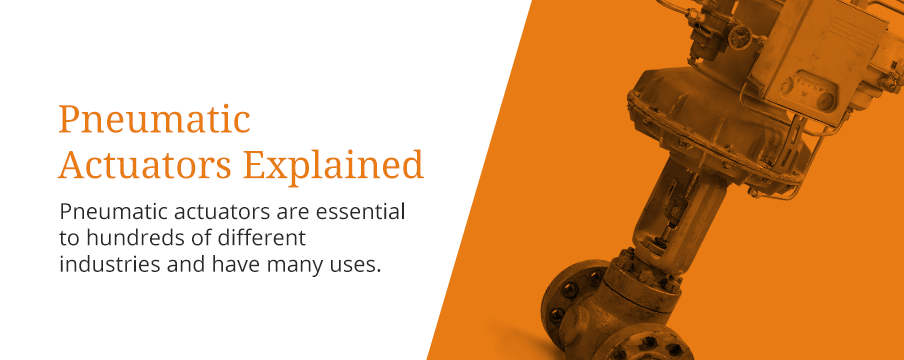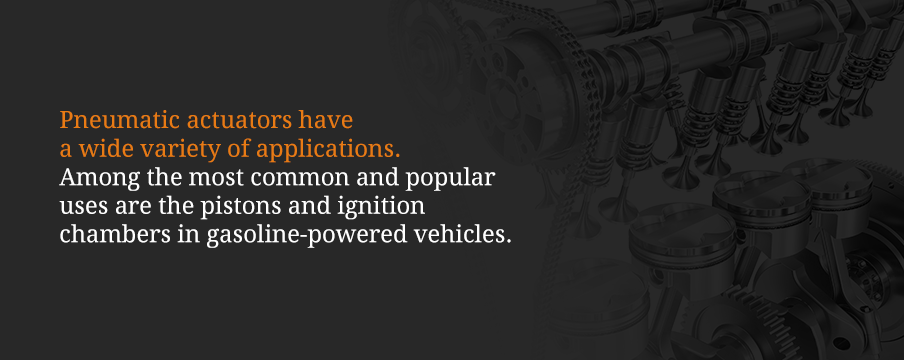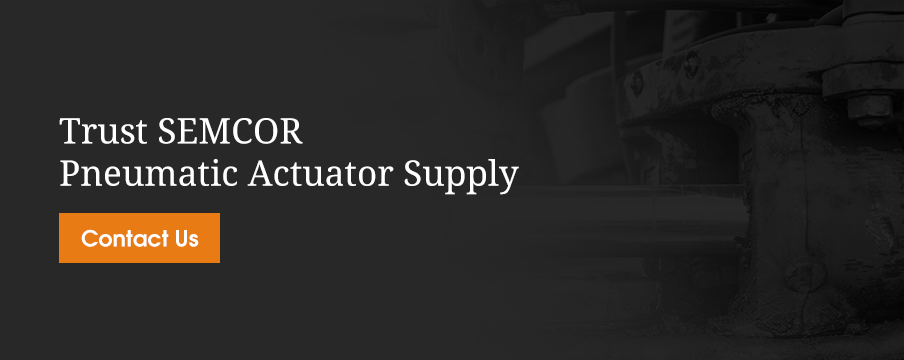How Pneumatic Actuators Work and Advantages of Pneumatic Actuators
Pneumatic Actuators Explained

Pneumatic actuators are essential to hundreds of different industries and have many uses. To understand how you can apply pneumatic cylinders, you should familiarize yourself with the fundamentals.
This guide will answer the questions: what is a pneumatic actuator, how does an actuator work, what are the different types available and what is the function of a pneumatic actuator?
What Is a Pneumatic Actuation System?
Pneumatic actuators are highly reliable, efficient and safe sources of motion control that use pressurized air or gas to convert energy into rotary or linear motion. They’re especially appropriate for the repeated opening and closing of valves and other industrial applications where the use of electricity may cause a fire or ignition hazard. Actuators are commonly used to control the valves that direct the movement of fluids in the chemical and process industries.
Pneumatic actuators have several different names, including pneumatic cylinders, air cylinders and air actuators. Each of these terms is synonymous with the other, as they all identify the device as air pressure based. Another name for an air cylinder is pneumatic ram, in which the ram is referring to the linear piston.
How Does a Pneumatic Actuator Work?
Pneumatic actuators rely on some form of pressurized gas — most often compressed air — entering a chamber, where the gas builds up pressure. When it has built up enough pressure in contrast to the outside atmospheric pressure, it results in the controlled kinetic movement of a device such as a piston or gear. This resulting movement can be directed in either a straight line or circular motion.
Since the conversion of compressed gas into energy can be highly controlled and is reliable and repeatable, pneumatic actuators are one of the most popular mechanical devices used in a wide array of modern industries.
Types of Pneumatic Cylinders
There are two primary varieties of pneumatic linear actuators — single-acting and double-acting. They both work to push forward a piston, but the main differences are the return method and number of ports.
Single-acting cylinders have one port that allows air to flow into the cylinder. The pressure increases and pushes the piston forward or backward, depending on whether it is a push or pull type. A large spring returns the piston to its original position, preparing it for another burst of pressure. The spring is either positioned inside the cylinder or on the outside.
Double-acting cylinders operate without a spring and instead have two ports, one on either end of the piston. The first application of pressure pushes the piston forward, a step in the process that the two models share. Then, the second burst of pressure on the other side of the cylinder pushes the piston back into place. The device applies pressure back and forth to create a smooth linear motion.
Typically, double-action cylinders are better for industrial uses that require speed and strength, as they provide more force at a faster rate. They may also offer a longer lifespan before needing replacement. However, they are a more expensive option in comparison. Single action cylinders also have other advantages besides cost. They have a more straightforward design, are more compact and require half the amount of compressed air to function.
Pneumatic Actuator Applications

Pneumatic actuators have a wide variety of applications. Among the most common and popular uses are the pistons and ignition chambers in gasoline-powered vehicles. They use ignition of the air and gasoline to create the pressurized force that eventually moves the piston and converts energy into the car’s crankshaft. However, the majority of pneumatic actuators rely only on pressurized gas with no ignition to produce the desired mechanical force.
In addition to the conventional combustible automobile engine, pneumatic actuators are essential in air compressors, packaging and production machinery, mail tubes and transportation equipment like railway and aircraft applications. They’re crucial in many other industrial situations that call for switch, pump or sensor control as well.
Pneumatic vs. Electric Actuators
While pneumatic cylinders work by way of pressurized air, electric actuators use electricity to function. Electric actuators are made up of a screw, coupler and motor, such as a stepper or servo. The screw turns and moves a nut, which makes the connecting rod or carriage shift the load. While pneumatic and electric actuators have similar uses, they aren’t directly interchangeable in every industry.
These two types of actuators vary in several other ways:
- Cost: Overall, pneumatic actuators have lower initial costs than the electric variety, but each has their purposes, and either could end up saving money in operating costs. Pneumatic cylinders are the most cost-efficient when the compressor size matches the number of cylinders it’s powering. Electric actuators provide the highest level of efficiency in moderate scales, though they have low operating costs in general.
- Force: In pneumatic actuators, speed and thrust are positively linked, meaning as one increases, the other does as well. In electric actuators, thrust and speed do not have the same link, as one decreases as the other increases. You can engineer them to perform differently, but it requires higher expenses.
- Control: Where pneumatic cylinders are better for industries that need force, electric actuators provide more accurate control and positioning. The standard models of the electric variety can move with precision from hundredths to thousandths of an inch.
Advantages of Pneumatic Actuators
The benefits of pneumatic actuators stem from both their overall safety and reliability. First of all, since pneumatic actuators can convert energy into motion without ignition or electricity, they’re highly sought after in situations where sparking and combustion cannot be tolerated. In these settings, compressed air can be stored and used in an efficient and repeatable manner that poses no fire risk.
Second, since pneumatic actuators that don’t rely on combustion can be manufactured easily and are relatively simple devices, they are also extremely durable, have minimal maintenance needs and offer a long operational life when used correctly.
Trust SEMCOR Pneumatic Actuator Supply
As one of the most reliable distributors of pneumatic actuators, SEMCOR is ready to supply you with the equipment you need from leading manufacturers. In addition, thanks to our outstanding expertise and customer care, the technical support that comes with all our actuators is unbeatable. Contact us now for product descriptions, selection guidance and more.
How Does a Pressure Transducer Work?
How Does a Pressure Transducer Work?

Pressure transducers are necessary for many industries. They measure pressure and create an electrical output proportional to the input. But with several different types of available models and many uses, it may be challenging to know how to choose the right model for your purposes. This guide will take you through what transducers are, how they work, the different types and potential applications.
What Is a Pressure Transducer?
A pressure transducer, sometimes referred to as a transmitter, is a device that turns pressure into an equally proportional electrical signal. Transducers use variable pressure sensors to measure deflection and resistance. The produced signal will be either a voltage, current or frequency, based on the applied pressure. Most types also require an electrical input, also called excitation. Transducers typically produce one of three types of output — millivolt (mV), voltage (V) and milliampere (mA).
How Does a Pressure Transducer Work?
The majority of transducers have a pressure-sensitive element that reacts to pressure entering through the transducer’s pressure port. As the sensing element or diaphragm is deflected due to the pressure’s force, it moves in relation to a resistor or capacitor plate. This, in turn, sends an output signal that is determined by the varying tension between the input signal, diaphragm position and core resistance.
There are three main types of transducer:
- Potentiometric pressure transducer: Potentiometric sensors are comprised of a precise potentiometer with an arm attached to a Bourdon or bellows. As the arm moves across the potentiometer, it converts the deflection into a measurement of resistance. The nature of these transducers allows them to be small in size and to work in tight spaces. They also produce a strong output, making them excellent for applications with low power.
- Capacitance pressure transducer: Capacitance sensors are sensitive and responsive, using a diaphragm transducer model to measure resistance. The diaphragm has a small space to travel, which means they work well in applications with low differential and absolute pressures.
- Resonant wire pressure transducer: Resonant wire transducers measure pressure with a wire attached to the sensor diaphragm. As the wire oscillates, pressure changes affect its tension, changing the frequency at which the wire is resonating. It results in exact measurements, and the transducer works well for applications with low differential pressures.
Depending on the model, transducers have a range of pressures they can measure and convert with accuracy. They operate best at between 50% and 60% of their maximum rated pressure. So, for a system operating at about 2,500 to 3,000 pounds per square inch (psi), a 5,000 psi rated transducer would work well.
Can External Factors Impact Pressure Transducers?

While most transducers are designed to produce a linear output in relation to the pressures they encounter, certain external variables can have an impact on their output signals. Nothing affects transducers more than temperature. That’s why almost all transducers are manufactured to be functionally accurate within a given temperature range. This sensitivity is due to the fact that as temperatures increase or decrease, there’s a resulting expansion or contraction in fluids and materials, which can change both the transducer’s mechanical and electrical properties and alter its calibration.
They also have a sensitivity to electromagnetic interference (EMI). If there are high field strengths present, it may change the pressure transducer’s electrical output. Fields strong enough to saturate the internal amplifiers can cause the transducer to produce inaccurate outputs, regardless of the amount of pressure. You can measure for external EMI and solve interference issues through shielding, grounding and routing techniques.
Different Types of Electrical Outputs
Pressure transducers are often differentiated by the electrical signal they create. There are three main types of available electrical output:
- Millivolt output transducers: The most economical choice of the three, mV transducers have a low electrical output. The exact output depends on the excitation levels. Since they have a low output signal, they’re susceptible to external electrical noise, making them better for non-industrial environments.
- Voltage output transducers: If you need a higher output level, consider voltage transducers. The actual output will depend on the model, but it is less dependent on excitation levels. Voltage output transducers are less affected by external electric sources, so they’re better for industrial environments.
- 4-20mA output transducers: Also known as pressure transmitters, the 4-20mA transducers produce a strong signal and can transmit them over long distances. They’re the least prone to electrical interference.
Pressure Transducer Applications
The types of transducers and their applications are as varied as the many industries that employ them. Four factors help determine which type of pressure transducer or transmitter needs to be installed in any given system:
- The particular device (e.g., programmable controller, microprocessor, panel meter) to which the transducer will be sending its output signal.
- The amount of EMI (electromagnetic interference) that will be encountered, such as in welding, power line and motor applications.
- The overall distance from the original pressure measurement and output signal to the device that will eventually receive the signal. Note: Transducers are the optimum choice for shorter distances, while transmitters are typically used in applications requiring sending signals over longer distances.
- The cost of the overall system and its installation.
Transducers are necessary for HVAC compressors and filtering, robotics and automation equipment, industrial transport and lifts, hydraulic feedback in weighing/scale systems and heavy-duty vehicles and power plants and fluid fuel systems.
Trust SEMCOR Transducer Supply
When it comes to expert advice on transducers, a large inventory, prompt delivery and superior technical support, look no further than SEMCOR. We’re your leading supplier of pressure transducers and transmitters from top manufacturers you can trust. Contact our sales and service staff for more product information and answers to all of your questions.




